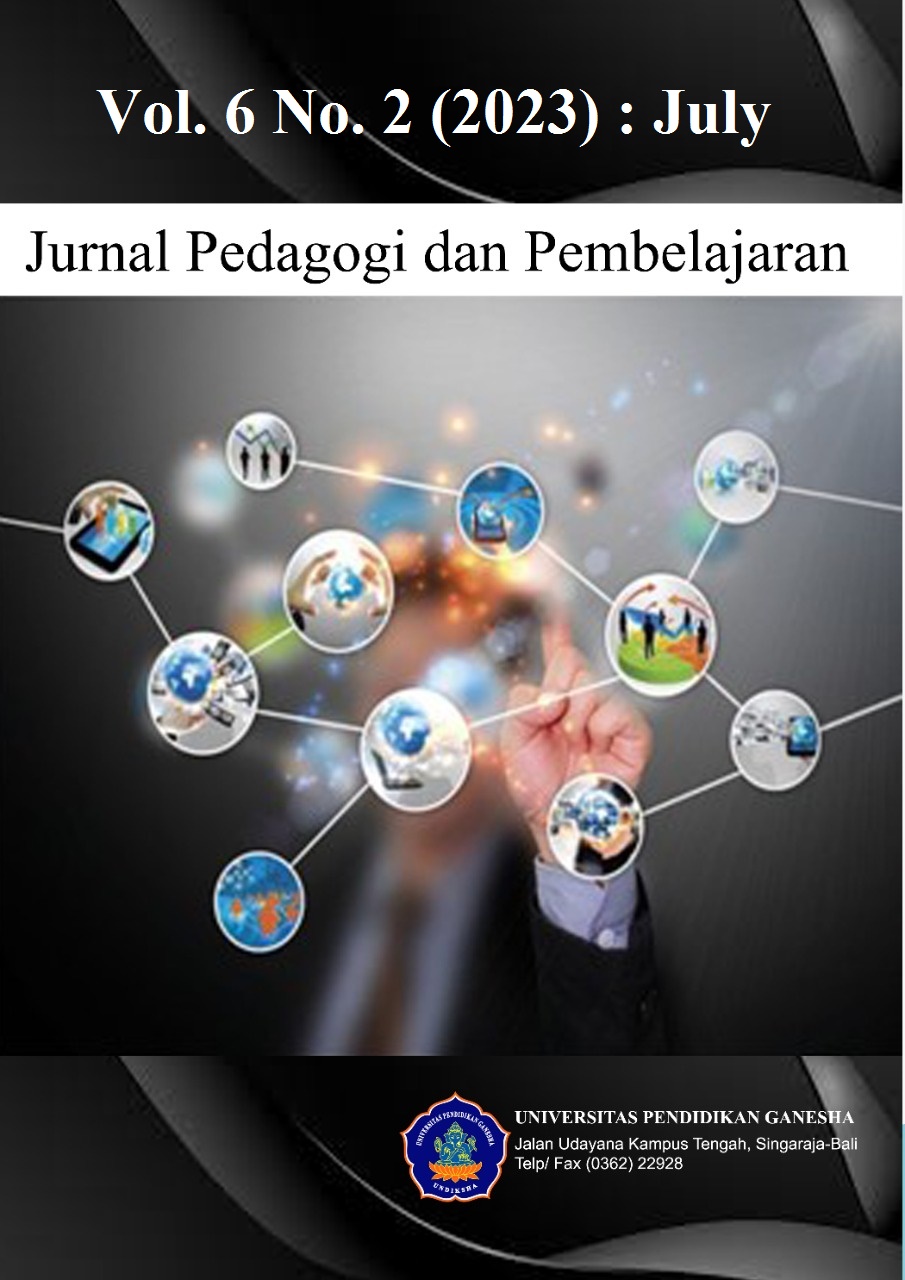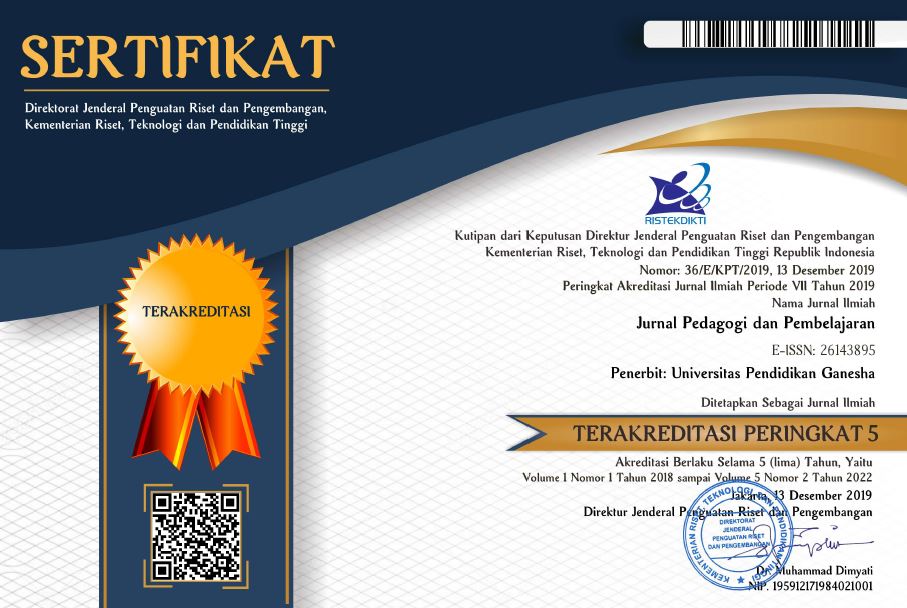A Mobile Learning Based-Creative Writing In Senior High School
DOI:
https://doi.org/10.23887/jp2.v6i2.56025Keywords:
Need Analysis, Mobile Learning, Creative WritingAbstract
In learning Indonesian, writing skills in high school are needed. However, in reality, secondary school students' creative writing abilities are still weak. Several studies state that high school students have yet to be able to write creatively optimally, and they are less motivated in the learning process. Based on the above, a solution is needed to overcome this. This study aims to describe the analysis of teacher needs for mobile learning-based learning media in creative writing learning in secondary schools to increase teacher and student literacy. The method used is the survey method. The sample of this research is 27 Indonesian language teachers. Data collection techniques used were questionnaires and interviews. The data analysis technique used is qualitative and quantitative analysis techniques. The results of the research show as follows. First, the media to be developed must comply with the principles of multimedia development, the characteristics of mobile learning, and the principles of learning to write. Second, there needs to be more learning media used so far. Third, teachers in secondary schools in Palembang need learning media based on mobile learning in learning creative writing.
References
Agustina, A. (2021). Peningkatan Prestasi Belajar Siswa pada Pelajaran Bahasa Indonesia Materi Menulis Teks Resensi dengan Menerapkan Model Pembelajaran Kooperatif Tipe Think Pair Share (TPS) di Kelas XI MIPA 1 SMAN 2 Bolo Semester II Tahun Pelajaran 2020/2021. Jurnal Pendidikan dan Pembelajaran Indonesia (JPPI), 1(2), 316–327. https://doi.org/10.53299/jppi.v1i2.93. DOI: https://doi.org/10.53299/jppi.v1i2.93
Al-Adwan, A. S., Al-Madadha, A., & Zvirzdinaite, Z. (2018). Modeling students’ readiness to adopt mobile learning in higher education: An empirical study. International Review of Research in Open and Distance Learning, 19(1), 221–241. https://doi.org/10.19173/irrodl.v19i1.3256. DOI: https://doi.org/10.19173/irrodl.v19i1.3256
Alsharida, R. A., Hammood, M. M., & Al-Emran, M. (2021). Mobile Learning Adoption: A Systematic Review of the Technology Acceptance Model from 2017 to 2020. International Journal of Emerging Technologies in Learning, 16(5), 147–162. https://doi.org/10.3991/ijet.v16i05.18093. DOI: https://doi.org/10.3991/ijet.v16i05.18093
Amalia, A., & Doyin, M. (2015). Pengembangan Buku Panduan Menyusun Teks Cerpen Dengan Menggunakan Teknik Urai Unsur Intrinsik Bagi Siswa Kelas Vii Sekolah Menengah Pertama (Smp). Jurnal Pendidikan Bahasa dan Sastra Indonesia, 4(1), 1–6.
Andriah, A., & Amir, M. F. (2021). Mobile Learning Based on Procedural and Conceptual Knowledge on Fractional for Elementary School. Jurnal Ilmiah Sekolah Dasar, 5(4), 567. https://doi.org/10.23887/jisd.v5i4.40819. DOI: https://doi.org/10.23887/jisd.v5i4.40819
Balqis, K., Purnomo, M. E., & Oktarina, S. (2021). Learning Media for Writing Fantasy Story Text Based on Scientific Plus Using Adobe Flash. Jurnal Ilmiah Sekolah Dasar, 5(3), 387. https://doi.org/10.23887/jisd.v5i3.35635. DOI: https://doi.org/10.23887/jisd.v5i3.35635
Bidin, S., & Ziden, A. A. (2013). Adoption and Application of Mobile Learning in the Education Industry. Procedia - Social and Behavioral Sciences, 90(InCULT 2012), 720–729. https://doi.org/10.1016/j.sbspro.2013.07.145. DOI: https://doi.org/10.1016/j.sbspro.2013.07.145
Brown, H. D. (2011). Prinsip Pembelajaran dan Pengajaran Bahasa. Kedutaan Besar Amerika Serikat di Jakarta.
Chen, P. S. D., Lambert, A. D., & Guidry, K. R. (2010). Engaging online learners: The impact of Web-based learning technology on college student engagement. Computers and Education, 54(4), 1222–1232. https://doi.org/10.1016/j.compedu.2009.11.008. DOI: https://doi.org/10.1016/j.compedu.2009.11.008
Cilliers, E. J. (2017). The Challenge Of Teaching Generation Z. PEOPLE: International Journal of Social Sciences, 3(1), 188–198. https://doi.org/10.20319/pijss.2017.31.188198. DOI: https://doi.org/10.20319/pijss.2017.31.188198
Devi, S., Rizwaan, M., & Chander, S. (2012). ICT for Quality Education in India. International Journal of Physical and Social Sciences, 2(6), 542–554.
Dwinita, Rena. Yakob, M. (2019). Kemampuan Siswa Kelas X SMA 4 Langsa Menulis Teks Biografi. Samudra Bahasa, 2(2), 13–20.
Ernalida, E., Oktarina, S., & Turama, R. (2021). Analysis of Teacher Needs Related To E-Learning Schoology Content in Creative Writing in Middle Schools Throughout Palembang City. English Review: Journal of English Education, 9(2), 277–284. https://doi.org/10.25134/erjee.v9i2.4352. DOI: https://doi.org/10.25134/erjee.v9i2.4352
Faisal, A. H., Zuriyati, Nf., & Leiliyanti, E. (2020). Media Pembelajaran Menulis Puisi Berbasis Aplikasi Android Untuk Siswa Sma. Kwangsan: Jurnal Teknologi Pendidikan, 8(1), 1. https://doi.org/10.31800/jtp.kw.v8n1.p1-18. DOI: https://doi.org/10.31800/jtp.kw.v8n1.p1-18
Faisal, M. (2022). Pengaruh Model Sinektik Terhadap Kemampuan Menulis Puisi Siswa Kelas V UPT SPF SD Inpres Bangkala II Kecamatan Manggala Kota Makassar. Jurnal Publikasi Pendidikan, 12(2), 146–149. https://doi.org/10.26858/publikan.v12i2.34109 Abstract. DOI: https://doi.org/10.26858/publikan.v12i2.34109
Faqih, M. (2021). Efektivitas Penggunaan Media Pembelajaran Mobile Learning Berbasis Android Dalam Pembelajaran Puisi. Konfiks Jurnal Bahasa Dan Sastra Indonesia, 7(2), 27–34. https://doi.org/10.26618/konfiks.v7i2.4556. DOI: https://doi.org/10.26618/konfiks.v7i2.4556
Firmadani, F. (2020). Media Pembelajaran Berbasis Teknologi Sebagai Inovasi Pembelajaran Era Revolusi Industri 4.0. Prosiding Konferensi Pendidikan Nasional, 2(1), 93–97.
Gazali, M., & Pransisca, M. A. (2021). Pentingnya Penguasaan Literasi Teknologi Informasi Dan Komunikasi Bagi Guru Madrasah Ibtidaiyah Dalam Menyiapkan Siswa Menghadapi Revolusi Industry 4.0. Jurnal Ilmiah Global Education, 2(1), 87–95. https://doi.org/10.55681/jige.v2i1.76. DOI: https://doi.org/10.55681/jige.v2i1.76
GebreYohannes, H. M., Hadi Bhatti, A., & Hasan, R. (2016). Impact of multimedia in Teaching Mathematics. International Journal of Mathematics Trends and Technology, 39(1), 80–83. https://doi.org/10.14445/22315373/IJMTT-V39P510. DOI: https://doi.org/10.14445/22315373/IJMTT-V39P510
Ghani, M. T. A., Hamzah, M., Daud, W. A. A. W., & Romli, T. R. M. (2022). The Impact of Mobile Digital Game in Learning Arabic Language at Tertiary Level. Contemporary Educational Technology, 14(1), 1–18. https://doi.org/10.30935/cedtech/11480. DOI: https://doi.org/10.30935/cedtech/11480
Guillén-Gámez, F. D., Lugones, A., Mayorga-Fernández, M. J., & Wang, S. (2019). ICT use by pre-service foreign languages teachers according to gender, age and motivation. Cogent Education, 6(1). https://doi.org/10.1080/2331186X.2019.1574693. DOI: https://doi.org/10.1080/2331186X.2019.1574693
Hidayah, N., Wahyuni, R., & Hasnanto, A. T. (2020). Pengembangan Media Pembelajaran Gambar Berseri Berbasis Pop-Up Book Untuk Meningkatkan Keterampilan Menulis Narasi Bahasa Indonesia. Jurnal Pendidikan dan Pembelajaran Dasar, 7(1). https://doi.org/10.24042/terampil.v7i1.6182.
Hikmatin, T. (2020). Pengaruh Minat Baca dan Penguasaan Kosakata terhadap Kemampuan Menulis Cerita Pendek. Diskursus: Jurnal Pendidikan Bahasa Indonesia, 1(03), 286. https://doi.org/10.30998/diskursus.v1i03.6696. DOI: https://doi.org/10.30998/diskursus.v1i03.6696
Hudhana, W. D. (2019). Pengembangan Media Video Scribe dalam Peningkatan Kemampuan Menulis Cerpen Berbasis Karakter Siswa Kelas X SMA se-Kabupaten Tangerang. Pena : Jurnal Pendidikan Bahasa dan Sastra, 9(1), 31–46. https://doi.org/10.22437/pena.v9i1.6839. DOI: https://doi.org/10.22437/pena.v9i1.6839
Imelda, Cahyono, B. Y., & Astuti, U. P. (2019). Effect of process writing approach combined with video-based mobile learning on Indonesian EFL learners’ writing skill across creativity levels. International Journal of Instruction, 12(3), 325–340. https://doi.org/10.29333/iji.2019.12320a. DOI: https://doi.org/10.29333/iji.2019.12320a
Jabar, S. A., & Ahmad, A. (2018). The design of multimedia interactive courseware for teaching reading to hearing impaired students. International Journal of Academic Research in Progressive Education and Development, 7(4). https://doi.org/10.6007/IJARPED/v7-i4/4849. DOI: https://doi.org/10.6007/IJARPED/v7-i4/4849
Juniarti, Y., Subadiyono, S., & Alwi, Z. (2021). The Need Analysis of Writing Module With Edmodo. English Review: Journal of English Education, 9(2), 419–426. https://doi.org/10.25134/erjee.v9i2.4457. DOI: https://doi.org/10.25134/erjee.v9i2.4457
Khairunnisa, F., Purnomo, M. E., & Oktarina, S. (2022). The Analysis of Test Instrument Needs for Indonesian Language Lesson. AL-ISHLAH: Jurnal Pendidikan, 14(1), 43–50. https://doi.org/10.35445/alishlah.v14i1.565. DOI: https://doi.org/10.35445/alishlah.v14i1.565
Kiryakova, G., Angelova, N., & Yordanova, L. (2018). The potential of augmented reality to transform education into Smart education. TEM Journal, 7(3), 556–565. https://doi.org/10.18421/TEM73-11.
Kuimova, M., Burleigh, D., Uzunboylu, H., & Bazhenov, R. (2018). Positive effects of mobile learning on foreign language learning. TEM Journal, 7(4), 837–841. https://doi.org/10.18421/TEM74-22.
Kusmiarti, R., & Hamzah, S. (2019). Literasi Dalam Pembelajaran Bahasa Indonesia di Era Industri 4.0. Seminar Nasional Pendidikan Bahasa dan Sastra, 1(1), 211–222.
Macalister, John & Nation, I. (2019). Language Currulum Design. Routledge. DOI: https://doi.org/10.4324/9780429203763
Meyer, R. . (2009). Multimedia learning prinsip-prinsip dan aplikasi. Cambrigde University Press.
MIHAIL-VADUVA, D. (2019). Quality Characteristics of Mobile Learning Applications. Informatica Economica, 23(4/2019), 72–88. https://doi.org/10.12948/issn14531305/23.4.2019.07. DOI: https://doi.org/10.12948/issn14531305/23.4.2019.07
Milawati, T. (2011). Peningkatan Kemampuan Anak Drama dan Menulis Teks Drama Melalui Model Pembelajaran Somatis Auidtiri Visual Intelektual (SAVI). Jurnal Penelitian Pendidikan, 14(2), 70–78.
Mohammad, R. (2018). English At Higher Education Level: A Need Analysis. International Journal of Research in English Education (IJREE), 3(2), 115–125. https://doi.org/10.29252/ijree.3.2.115. DOI: https://doi.org/10.29252/ijree.3.2.115
Murniyati, T. (2016). Pengembangan Media Pembelajaran Menulis Puisi Bermuatan Pendidikan Karakter Berbasis Android Siswa Kelas VIII SMP Negeri 1 Kampak Trenggalek. Nosi, 4, 344–359.
Nopriyanti, N., & Sudira, P. (2015). Pengembangan Multimedia Pembelajaran Interaktif Kompetensi Dasar Pemasangan Sistem Penerangan Dan Wiring Kelistrikan Di SMK. Jurnal Pendidikan Vokasi, 5(2). https://doi.org/10.21831/jpv.v5i2.6416. DOI: https://doi.org/10.21831/jpv.v5i2.6416
Nugraha, C. A., & Wahyono, S. B. (2019). Developing Interactive Multimedia Learning for Psychomotor Domain to Students of Vocational High School. Jurnal Kependidikan: Penelitian Inovasi Pembelajaran, 3(2), 220–235. https://doi.org/10.21831/jk.v3i2.21797. DOI: https://doi.org/10.21831/jk.v3i2.21797
Nuryadi, N., Kurniawan, L., & Kholifa, I. (2020). Developing mobile learning based on ethnomathematics viewed from adaptive e-learning: Study of two dimensions geometry on Yogyakarta palace’s chariot. International Journal of Education and Learning, 2(1), 32–41. https://doi.org/10.31763/ijele.v2i1.85. DOI: https://doi.org/10.31763/ijele.v2i1.85
Nuzulia, D. (2016). Pengaruh Penggunaan Media Diorama Papercraft Terhadap Kemampuan Menulis Cerpen Siswa Kelas X Sma Negeri 10 Palembang. Jurnal Ilmu Kependidikan, 4(1). https://doi.org/10.31851/wahanadidaktika.v14i1.564.
Ozdamlia, Felize & Cavus, N. (2011). Basic elements and characteristics of mobile learning. Social and Behavioral Sciences, 937–942. https://doi.org/10.1016/j.sbspro.2011.11.173. DOI: https://doi.org/10.1016/j.sbspro.2011.11.173
Parnawati, Tantry & ulinuha, A. (2019). English At Higher Education Level: A Need Analysis. Journal of English Education and Applied Linguistics, 8(2), 214–225. https://doi.org/10.24127/pj.v8i2.2296. DOI: https://doi.org/10.24127/pj.v8i2.2296
Putri, Bellla Nindi Harianti ., Suyatno,&sodiq, S. (2020). Pengembangan Media Pembelajaran Menulis Teks Cerita Fantasi Berbasis Aplikasi Android Ayo Berfantasi Bagi Siswa Kelas VII SMP Dengan Pendekatan Saintifik. Jurnal Educatin and Development, 8(4), 337–341.
Richardson, M., Gorley, M., Wang, Y., Aiello, G., Pintsuk, G., & Gaganidze, E. (2021). Technology readiness assessment of materials for DEMO in-vessel applications. Journal of Nuclear Materials, 550. https://doi.org/10.1016/j.jnucmat.2021.152906. DOI: https://doi.org/10.1016/j.jnucmat.2021.152906
Roysa, M. (2015). Kemampuan Menulis Cerpen Dengan Perlakuan Model Pengajaran Tidak Langsung Dan Model Kooperatif Integratif Pada Siswa Sma Dilihat Dari Tingkat Kemandirian Siswa. Refleksi Edukatika, 4(2), 1–13. https://doi.org/10.24176/re.v4i2.418. DOI: https://doi.org/10.24176/re.v4i2.418
Sadeli, L. (2020). Pembelajaran Model Gambar Dan Sugesti Imajiner Terhadap Kemampuan Menulis Puisi Dan Sastra. Jurnal Soshum Insentif, 3(2). https://doi.org/10.36787/jsi.v3i2.374. DOI: https://doi.org/10.36787/jsi.v3i2.374
Santoso, A., & Lestari, S. (2019). The Roles of Technology Literacy and Technology Integration to Improve Students’ Teaching Competencies. KnE Social Sciences, 3(11), 243. https://doi.org/10.18502/kss.v3i11.4010. DOI: https://doi.org/10.18502/kss.v3i11.4010
Sigut, J., Castro, M., Arnay, R., & Sigut, M. (2020). OpenCV Basics: A Mobile Application to Support the Teaching of Computer Vision Concepts. IEEE Transactions on Education, 63(4). https://doi.org/10.1109/TE.2020.2993013. DOI: https://doi.org/10.1109/TE.2020.2993013
Supiarza, H., & Sarbeni, I. (2021). Teaching and learning music in digital era: Creating keroncong music for gen z students through interpreting poetry. Harmonia: Journal of Arts Research and Education, 21(1), 123–139. https://doi.org/10.15294/harmonia.v21i1.28585. DOI: https://doi.org/10.15294/harmonia.v21i1.28585
Tovar Viera, R., Velasco Sánchez, Diego IsmaelTovar Viera, R., & Velasco Sánchez, D. I. (2020). Research on Technology Competencies in EFL Language Instructors: Technology-Pedagogy-Content in Language Teaching. Script Journal: Journal of Linguistics and English Teaching, 5(1), 32–43. https://doi.org/10.24903/sj.v5i1.414. DOI: https://doi.org/10.24903/sj.v5i1.414
Wati, E. K., & Wulansari, W. (2021). LOP Game Development to Improve Early Childhood Mathematical-Logic Learning Ability. JPI (Jurnal Pendidikan Indonesia), 10(1), 68–78. https://doi.org/10.23887/jpi-undiksha.v10i1.28406. DOI: https://doi.org/10.23887/jpi-undiksha.v10i1.28406
Yundayani, A., Emzir, E., & Rafli, Z. (2017). Need Analysis: the Writing Skill Instructional Material Context for Academic Purposes. English Review: Journal of English Education, 6(1), 59. https://doi.org/10.25134/erjee.v6i1.771. DOI: https://doi.org/10.25134/erjee.v6i1.771
Zahwa, F. A. (2022). Pemilihan Pengembangan Media Pembelajaran. Jurnal penelitian pendidikan dan ekonomi, 19(01), 61–78. https://doi.org/10.25134/equi.v19i01.3963. DOI: https://doi.org/10.25134/equi.v19i01.3963
Zamili, U. (2020). Pembentukan Kepribadian Mental Spiritual Generasi Milenial di Zaman Digital Ditengah Pandemi Covid 19. Prosiding Seminar Nasional Multidisiplin Ilmu Universitas Asahan ke-4 Tahun 2020, 53(9), 326–333.
Downloads
Published
How to Cite
Issue
Section
License
Copyright (c) 2023 Santi Oktarina, ernalida ernalida, ansori ansori

This work is licensed under a Creative Commons Attribution-ShareAlike 4.0 International License.
Authors who publish with Jurnal Pedagogi dan Pembelajaran agree to the following terms:- Authors retain copyright and grant the journal the right of first publication with the work simultaneously licensed under a Creative Commons Attribution License (CC BY-SA 4.0) that allows others to share the work with an acknowledgment of the work's authorship and initial publication in this journal
- Authors are able to enter into separate, additional contractual arrangements for the non-exclusive distribution of the journal's published version of the work (e.g., post it to an institutional repository or publish it in a book), with an acknowledgment of its initial publication in this journal.
- Authors are permitted and encouraged to post their work online (e.g., in institutional repositories or on their website) prior to and during the submission process, as it can lead to productive exchanges, as well as earlier and greater citation of published work. (See The Effect of Open Access)













